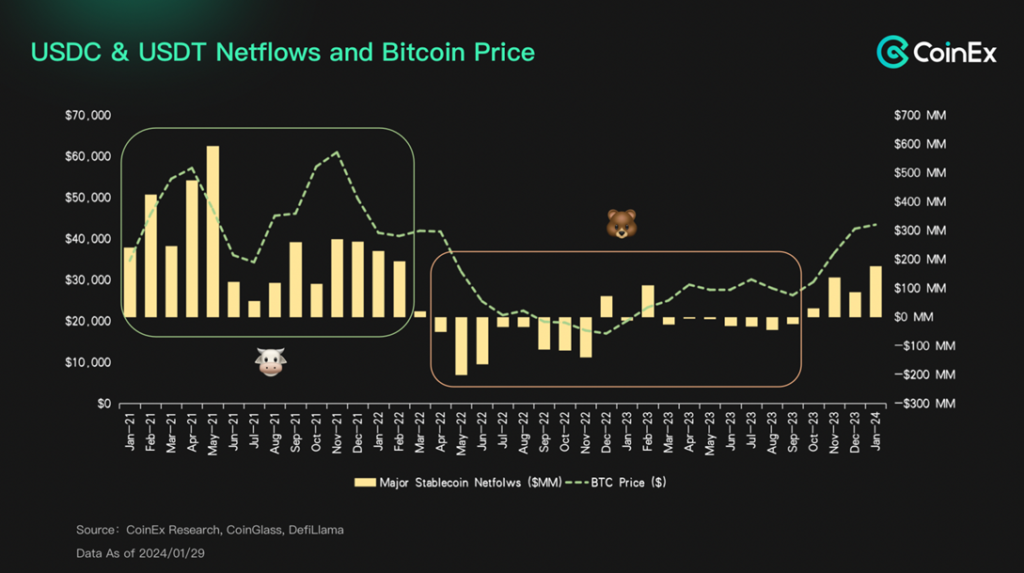“We have finally become Wall Street traders.” – Bitcoin Spot ETF Approval
The long-anticipated Bitcoin spot ETF has finally gained approval, marking a milestone event in the broader acceptance of Bitcoin and cryptocurrencies. “We have finally become Wall Street traders.” However, this is just the beginning, and the market need more patience to await the influx of institutional inflows. Typically, for institutions to make investment into a new category like Bitcoin ETFs, it may take several months or more for internal investigations and approvals.
Currently, there are 11 approved Bitcoin ETFs, with a total assets under management (AUM) of $27.2 billion. The top three in market capitalization are GBTC, IBIT, and FBTC, respectively. It is foreseeable that there will be intense competition for market share among issued ETFs, with only 2-3 ETFs likely to remain in the end.
Dumping & Dumping – Grayscale BTC Outflow
Although Grayscale is the most experienced management company for spot BTC, its ETF has encountered significant sell-offs after issuance. The main reason for the sell-off is its management fee (1.5%), which is much higher than other ETFs. Due to differences in settlement mechanisms, the sell-off of Grayscale ETF shares results in the immediate sale of BTC on the secondary market, while inflows from other ETFs are recorded with custody institutions like Coinbase and do not immediately translate into secondary market purchases. This has led to significant selling pressure on BTC in the recent period.
It can also be observed that the capacity of other ETFs to absorb the outflow of GBTC shares is gradually decreasing, with net outflows in the last four trading days.
Although Grayscale’s BTC holdings have decreased from a peak of 600,000 coins to around 500,000 coins, and the selling pressure is gradually diminishing, it is expected that selling pressure from Grayscale will persist. The final holding range is estimated to be around 40-50% of the peak, with approximately 200,000 to 250,000 BTC yet to be sold. At the current average rate of 10,000 coins per day, the market is expected to experience around 20 days of “Grayscale pressure.”

Macro Data Spotlight – Strong Stablecoin Inflows
The netflow of USDC and USDT are important indicators at the macro level reflecting bull and bear markets. Currently, the market has experienced four consecutive months of net inflows, stepping out of the bear market territory marked by net outflows. However, the inflow volume has not yet reached the peak levels seen in a bullish market. Overall, market sentiment has completed the transition from bear to bull, and the influx of funds exhibits characteristics typical of the early stages of a bull market.
Positive fund inflows have also reversed the previous situation of a stock game, with currencies other than Bitcoin (altcoins) receiving more capital injection.

Macro Data Spotlight – Cooling Down On BTC Rally
After the approval of the ETF, BTC did not experience a faster price surge. On the contrary, due to the speculative narrative around the BTC ETF, the price had been pushed from around $20,000 in August of the previous year to a peak of about $49,000 when the ETF was approved. When the ETF was actually approved, what we witnessed was more of a “Sale-the-News” phenomenon and short-term profit-taking. BTC has entered a period of adjustment, which is expected to continue into February. However, because of favorable market sentiment, the price correction may not be significant, and there might be more of a range-bound movement.
Also, currently BTC’s perpetual contract Open Interest remains at a high level (~$17 billion), which means the market leverage is still relatively high. This may hinder significant upward price movements. It is necessary for a retracement to a relatively healthy level (in the range of $13 billion to $16 billion) to gather strength for the next strong upward movement.

What Is Ahead – SEC vs. Binance & Coinbase: Ongoing Lawsuit
The U.S. Securities and Exchange Commission (SEC) filed lawsuits against Coinbase and Binance in June of last year, accusing these companies of listing digital assets like Solana (SOL) and Filecoin (FIL) and claiming that these assets are essentially unregistered securities. In two hearings held in January of this year, the judge did not immediately issue a ruling but rather took the matter under careful consideration. Subsequent hearings and related rulings will be crucial and require close attention.
A significant portion of the U.S. cryptocurrency industry may depend on the outcome of the SEC’s cases against Coinbase and Binance. If federal judges acknowledge various digital assets as securities and grant the SEC the authority to determine which ones are securities, this could impose new registration and reporting requirements on issuers and trading platforms. Conversely, if judges unanimously believe that the SEC has exceeded its jurisdiction or that Congress should enact some tailored laws, it could signal a green light for the majority of businesses in the industry.
Economic Data to Watch in Feb 2024
The Federal Reserve will announce its interest rate decision on February 1st, followed by a speech from Federal Reserve Chair addressing the latest monetary policy developments. Due to the relatively weak labor market in recent times, there is an expectation for the first interest rate cut to occur in March. Additionally, the Consumer Price Index (CPI) and non-farm payroll data on February 13th are also worth monitoring.



